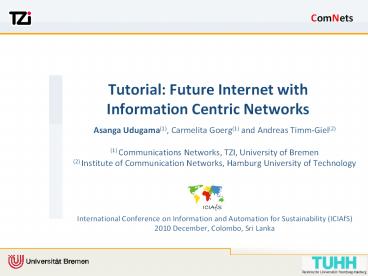Tutorial: Future Internet with Information Centric Networks - PowerPoint PPT Presentation
1 / 26
Title:
Tutorial: Future Internet with Information Centric Networks
Description:
Tutorial: Future Internet with Information Centric Networks Asanga Udugama(1), Carmelita Goerg(1) and Andreas Timm-Giel(2) (1) Communications Networks, TZI ... – PowerPoint PPT presentation
Number of Views:114
Avg rating:3.0/5.0
Title: Tutorial: Future Internet with Information Centric Networks
1
Tutorial Future Internet with Information
Centric Networks
Asanga Udugama(1), Carmelita Goerg(1) and Andreas
Timm-Giel(2) (1) Communications Networks, TZI,
University of Bremen (2) Institute of
Communication Networks, Hamburg University of
Technology
International Conference on Information and
Automation for Sustainability (ICIAfS) 2010
December, Colombo, Sri Lanka
2
Contents
- Motivation
- Requirements
- Known Architectures
- CCN Described in detail
- Mechanisms Adopted
- Future Direction
3
- Motivation
4
Motivation
Source Van Jacobsen, PARC
- Commercial computing came into being during the
late 60s and early 70s - Networking was introduced for resource sharing
- Named hosts
- Model is point-to-point
5
Motivation
- Movement of content
- Predicted global IP traffic in 2014 64
exabytes/month (4 fold from 2009) (1) - 180 exabytes of content created in 2006 (2)
- Global mobile traffic will double every year
(mostly streaming content) (2) - Current solutions P2P and CDNs
- Location orientation of content
- Content associated with named hosts
- Sender orientation
- Sender can send anywhere
- Securing content
- Point-to-point model
- TLS and SSL secures endpoints
(1) IDC (March, 2008). "An Updated Forecast of
Worldwide Information Growth Through 2011 (2) P.
Jokela, et al, LIPSIN Line Speed
Publish/Subscribe Inter-networking, SIGCOMM 2009
6
Motivation
- Mobility and multi-homing
- Device mobility is the norm
- Multiple attachments
- Mobility currently based on routing or
indirection - Adaptation to disruptions
- Challenged networks sparse connectivity,
high-speed mobility, disruptions - Problems with network based caching
- DRM issues
- Security
7
- Requirements (Expectations)
8
Requirements
- Information as the first class citizen
- Named content not named hosts
- Security from inception
- Trusted
- Prevent attacks
- Protection from spam
- Flexible and reliable routing
- Should include multi-path content delivery
- Built-in mobility support
- Addressing
9
- Known Architectures
10
Known Architectures
- Architectures
- Sienna (Publish/Subscribe)
- Data Oriented Networking Architecture (DONA)
- Publish Subscribe Internet Routing Paradigm
(PSIRP) - Network of Information (NetInf)
- Content Centric Networking (CCN)
- Operation Differentiation
- Naming
- Security
- Routing
- Caching
- Content existence knowledge
- Producer-consumer meeting
11
Content Centric Networks Operation
Check Pending Interests Table
Interest
Data
Check Content Store
Check Pending Interests Table
Check Forwarding Information Base
12
Content Centric Networks Stack
(1)
- Change of network abstraction from named hosts
to named content - Security built-in secures content and not the
hosts - Mobility is present by design
- Can handle static as well as dynamic content
- Use of 2 messages Interest and Data Object
(1) Van Jacobson, et al, Networking Named
Content, CoNEXT 2009
13
Content Centric Networks Architecture
- Each CCN entity has 3 main data structures
- Content Store, Pending Interest Table, Forwarding
Information Base - Uses multicast/broadcast
- Uses longest prefix matching lookup for content
names
14
Content Centric Networks Messages
- Purpose of messages
- Interests request for content
- Data serves these requests
- No fixed length fields and uses an XML encoding
format
15
Content Centric Networks Names
- Core of CCN uses content names for forwarding
- Applications can interpret names the way they
want
16
Content Centric Networks - CS
- Uses longest prefix matching
- Implements policies such as LRU or LFU for
content replacement - Content do not necessarily have to be persistent
(only cached)
17
Content Centric Networks PIT
- Uses longest prefix matching
- An entry may point to multiple faces
- Must time out and not held permanently
18
Content Centric Networks FIB
- Uses longest prefix matching
- Similar to IP FIB
- Destination may have number of faces
19
Content Centric Networks Interest
20
Content Centric Networks Data
21
- Mechanisms Adopted
22
Mechanisms Adopted Summary I
- Content Centric Networks
- Naming Hierarchical naming, single address
- Security Signed content
- Routing Longest prefix matching
- Caching Local or network based
- Content existence knowledge Not part of the CCN
core - Producer-consumer meeting Propagation of
interests - Network of Information
- Naming Flat naming
- Security Signed content
- Routing (1) Name resolution (2) Information
transfer - Caching Network based
- Content existence knowledge Through name
resolution service - Producer-consumer meeting Name resolution
service provide locations
23
Mechanisms Adopted Summary II
- Publish Subscribe Internet Routing Paradigm
- Naming Multi-level identifiers
- Security Signed content
- Routing (1) Name resolution (2) Information
transfer - Caching Network based
- Content existence knowledge Registrations in
Rendezvous system - Producer-consumer meeting Rendezvous system
provides location - Data Oriented Networking Architecture
- Naming Flat naming
- Security Signed content
- Routing Queries are resolved to locations
- Caching Network based
- Content existence knowledge Through resolution
infrastructure - Producer-consumer meeting Resolution
infrastructure provides location
24
- Future Direction
25
Future Direction
- Projects (past and present)
- FP7 4WARD, SAIL
- FP7 PSIRP, PERSUIT
- FIA NDN
- Areas to consider
- Naming (flat, hierarchical, mixed)
- Architecture (Publish-subscribe or
request-response) - Security (hacked algorithms)
- Coexistence (different architectures)
- Migration (legacy networks)
- Scalability
- Privacy
- Deployment (users, access network operators,
connectivity network operators content providers,
application developers)
26
- Thank you. Questions?































